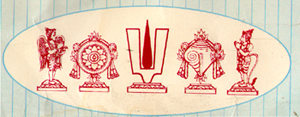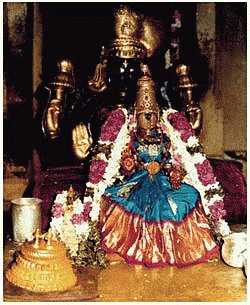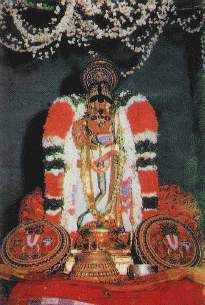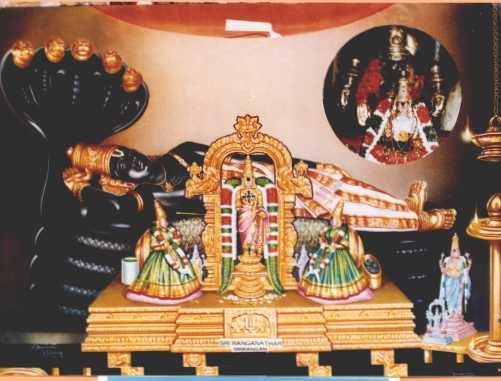









This temple, 6 KMS north of the city, is among the most revered shrines to Lord Vishnu in South India, and probably, the largest temple complex in India. Enclosed by seven rectangular walled courtyards, this 13th century temple has 21 gopurams among which Rajagopuram is the largest in south India. The rajagopuram was built in 1987. The remaining were built between 14 th and 17 th centuries. The town, and the temple, are set on a 250-hectare island in the Cauvery, connected to the mainland by a bridge. The temple is very well preserved, with excellent carvings, and numerous shrines to various Gods, though the main temple is dedicated to Vishnu.
Srirangam, the premier Vaishnava temple in South India is the first and foremost among the 108 Vaishnava divyadesas. All the Alvars have sung in praise of the deity enshrined in the huge temple in the center of the town. The Sri Vaishnava Acharyas from Nathamuni are found to have taken an active and abiding interest in the management of the temple. During Ramanuja's time, far reaching reforms were introduced both in the religious and secular management. Thus Srirangam has an eventful history, both secular and religious, as the great Vaishnava Acharyas made it the headquarters of the wider Vaishnava movement. Here is an attempt to present its eventful history in a nutshell - both the traditional and historical.
In the Vaishnava parlance, the term "Koil" signifies the Srirangam temple only. The temple is enormous in size. The temple complex is 156 acres in extent. It has seven Prakaras or enclosures or Tiru Veedhis. These enclosures are formed by thick and huge rampart walls which run round the sanctum. The total length of these seven walls is 32,592 feet or over six miles. There are magnificent towers in all Prakaras providing a unique sight to any visitor. The latest addition is the 236 feet high stupendous thirteen tired Rajagopuram built at the southern rampart by the late 44th Jeeyar of the Sri Ahobila Mutt and consecrated in 1987 with great fanfare and religious piety. The grandeur of the towers decrease as one moves away from, them towards the sanctum signifying that the devotee has to move away from the lofty earthly attachments in his spiritual quest.
The Peria Koil is complete in all respects. It has the full complement of seven Prakaras. It has a main shrine where the Lord (Ranganatha) is found in a reclining posture in his serpent bed. There are also sub shrines for Vishvaksena, Rama, Krishna, Nachiyar, Chakratalvar, Garuda, Hanuman, Andal etc. and for all the alvars and the acharyas upto Vedanta Desika within the precincts.
The Peria koil lies on an islet, formed by the twin rivers Kaveri and Kollidam. The river has always been a very important adjunct of a Hindu temple or religious institutions and therefore held as sacred as the temple.
The origin of the glittering Sriranga Vimana is said to have been narrated by Rudra to Narada. According to the Sriranga Mahathmya the glittering Sriranga Vimana sprang as a result of the tapas of Brahma in the depths of the Milky ocean. It was borne by the celestial bird Garuda. Adisesha, had spread his hood over it. Vishvaksena, the Archangel-in-chief walked in front clearing the way. The Sun and Moon were fanning the Deity. The celestial Musicians Narada and Thumburu followed singing His Glory. Rudra and other gods raised the "jayaghosha". The celestial maids danced. There was a rain of flowers.
Awakened from his deep tapas, Brahma prostrated before the Vimana. He recited the four vedas and gazed in wonderment. Sunanda, a celestial guard informed him that the Lord was pleased with his penance and had come in answer to his prayers. When Brahma looked into the Vimana, he found there the Supreme Lord resting with his Consorts. The Lord informed Brahma that he had come as a Svayamvyakta -- on his own volition -- as an idol. He would appear likewise in eight places on earth -- Srirangam, Srimushnam, Venkatadri, Saligram, Naimisaranya, Totadri, Pushkara and Badri. Ranga Vimana is the first and the earliest of all these. The Lord directed Brahma to worship him strictly according to the procedure for worship laid down in the Agamas and lay down in his characteristic posture, in Yoganidra.
Brahma carried it to Satyaloka and installed it on the banks of the river, Viraja. He appointed the Sun god to do the daily pooja. After him, Vaivasvata Manu, performed the worship. When his son Ikshvaku, became the King of Ayodhya, he wanted to have it installed at Ayodhya. He entered on a tapas which lasted for many hundred years at the end of which he was permitted by Brahma to take it to Ayodhya.
Thus, the Vimana came to Ayodhya. After Ikshvaku, his descendants continued the service. Rama, himself an avatara of the Lord worshipped him and thereafter the Lord came to be known as "Periya Perumal". On his triumphant return from Sri Lanka, in the coronation held in grand style, Rama gave the Vimana as gift to Sri Vibheeshana for worship.
When Vibheeshana set out for Sri Lanka, He got down on the Kaveri bank to perform his mid-day prayers. He placed the Ranga Vimana at a place known as "Sesha Peetam" near the Chandrapuskarani. He returned after taking his bath and performed the Pooja and lo! when he tried to lift the Vimana, it would not move. It had got stuck up. Vibheeshana was overcome with grief and shed tears. The Lord appeared before him and consoled him saying that he need not grieve as He had already decided to make the place His abode. He could come and worship him daily. It is said that Vibheeshana worships the Lord daily at midnight.
A chola by name Dharma Varma who was then ruling the territory, had seen the Ranga Vimana at the Yagasala when Dasaratha performed the Putrakameshti Yaga. He was so fascinated that he wanted to have it installed in his region. When he undertook a tapas on the banks of Chandrapushkarani, the sages told him that Sri Ranga Vimana was expected to arrive any time and requested him to give up the penance.
Soon the "Sriranga Vimana" carried by Vibheeshana had arrived and the episode (explained above) had taken place. Dharma Varma was overjoyed as the Lord had willed to make it his abode. He built a shrine for the Vimana, the surrounding Prakara known as "Dharma Varma Veedhi" and arranged for proper daily worship.
In course of time, Nature devoured the site. The Sri Ranga Vimana and the structures disappeared and became a habitat for wild animals. A ruling prince of the Chola dynasty hunting to that spot overheard a parrot repeating a sloka.
Kaveree
Viraja Seyam Vaikuntam Rangamandiram
Sa Vasudevo
Pangeshah Pratyaksham Paramam Padam |
Vimanam
Pranavakaram Vedasrungam Mahadhbhutham
Srirangasayee
Bhagavan Pranavarthaprakasakah ||
The river Kaveri is the very same river Viraja that eternally flows in Vaikunta, Srirangam Temple is verily Vaikuntam itself, the Abode of Lord Vishnu where he sits in all splendour and majesty in the company of Nityasuris.
The Lord of Arangam, is none but Vasudeva, the Primeval Lord Himself. The Vimana is verily the external Paramapada itself.
The Vimana is in the form of the Pranava (the life sustaining mantra). The four towers are marvelously akin to the four Vedas and the Lord, Sri Rangasayee is expounding the import of the Pranava.
On understanding the import of this sloka, the chola caused the earth towards the west of the tree (known as Tirumudikkurai) to be dug deep to lay a secure foundation for the Sriranga Vimana. But the Lord appeared before him in a dream and pointed out to him the exact spot wherein he lay. The king was overjoyed at finding the glittering Ranga Vimanam there. He cleared the forest, constructed all the essential parts of the temple, laid down flower gardens, instituted temple services and forms of worship. The shrine became widely knows as "Tiruvaranga Tirupathi", thanks to the benefactions of Kili Chola and his successors who ruled from Uraiyur.
With the rise of Buddhism and Jainism in the Tamil country, there arose a strong reaction against their growing influence. This found expression in a wide movement among the worshippers of Vishnu and Siva. The Vaishnava resurgent movement was spearheaded by the Alvars who brought religion to the heart of the people. They employed Tamil (the local language) as the medium of expression and composed the exuberant devotional songs - celebrated as the "Nalayira Divya Prabandham".
The shrines visited and glorified by them became holy places (Divya Desas). The temple at Srirangam and the Deity enshrined therein have been sung by all of them.

Home Trichy Map Tiruvanaikoil Schools Colleges Tel.Nos. Hotels More